The wagons built by the Romans were unsurpassed in engineering and technology until well after the Middle Ages. "Altogether, a range of vehicles was created in the Roman era which that would satisfy the needs of European society for the next thousand years."1. To understand the Roman wagon is to know something about the wagons built and used in the Middle Ages. The technology of wagons as it existed in Roman Imperial times underwent no improvements throughout the Middle ages. Instead there is evidence which suggests that the technology declined in the early Middle Ages. The level of Roman wagon technology with suspension systems and single piece fellies was unreached until the 18th century or later. Although some authors cite the importance of dished wheels which were introduced after the Middle Ages2, they did not have the impact on wagon technology that the rediscovery of the Roman pivoting front axis and suspension system did. The reality was that in the Middle Ages, as in Roman times, oxen still pulled the very heavy loads and indeed to support these heavy loads, the heaviest wood was used to build the wagons. In fact John Langdon notes that oxen were used to pull wagons built from oak wood and horses were used to pull wagons font made from lighter woods such as ash 3, since oak is heavier than ash and can sustain a greater load.
So what sort of technology in Wagon construction did the Romans have? The wagons were of either a 2-wheeled, or 4-wheeled variety. A casual look at any Roman iconography will show a wide variety of wagons in use for various purposes.
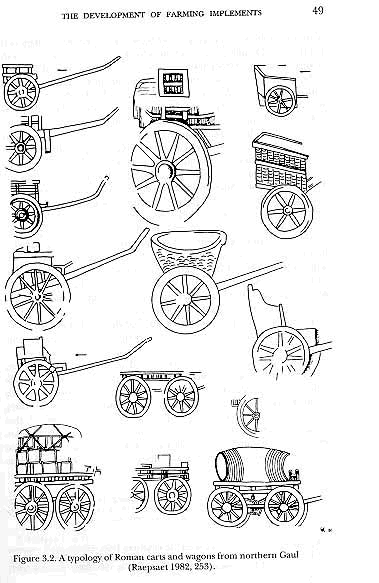
Fig. 17.Gallo-Roman Wagons4
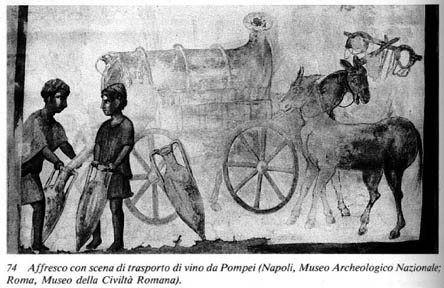
Fig 18. Pompeiian Wine wagon5
The construction of wheels was especially sophisticated. The wheels contain either 8 or 12 spokes and were banded with iron6. Single piece fellies were employed in wheel construction, thereby indicating a high level of woodworking technology7. Roman wheels were discovered in Newstead, Scotland, the fellies of which were made from single pieces of bent ash8. The hub appeared to have been turned on a lathe and is lined with an iron ring9. Archaeological evidence suggests that the skills of the wheelwright deteriorated after the German invasions of Western Europe10. As a matter of fact single piece fellies were not re-invented until after 1775.11
Of even greater import for our knowledge of Roman wagon technology were the excavations at Neupotz at which the remains of numerous plaustra or lorry type wagons were discovered. Based on coins and other artifacts found at the site, archaeologists date the finds to be from A. D. 278.12. It is the first archaeological find of such a lorry, only known from reliefs before.13 One of the most interesting finds is in the area of the construction of the axle. Although the axles were made of wood, they were reinforced with iron bushings. Archaeologists found 48 nave or hub rings used to strengthen the hub, which were preserved with wood pieces and 48 iron nave bushings, which were placed inside of the wheel hub14. (See Figure 19A)

Fig. 19A. Iron Wheel fittings from Neupotz15
As I have already point out the interior of the wheel hubs were also lined with metal; this meant that when the wheel turned, the friction would not be wood against wood or wood against metal , but rather metal against metal. Writers such as Cato and Pliny told their readers how to make axle grease. Cato in De Re Rustica recommended the boiling of olive lees to the consistency of honey for use as axle grease and preserving leather16. Pliny in his Natural History spoke of using pig grease17. In fact wooden axles were used during Antiquity and the Middle Ages18. But there is no evidence that the technology to create iron axle bushings existed in the Middle Ages.
From the Neupotz find it appears obvious that the Romans used iron with a low carbon content to reinforce the wagon. At Neupotz excavators also unearthed eight iron axle fittings, which were used as reinforcements of the wooden axle at the lower side of the axle along the wheel where the nave bushing was placed.19 These metal supports were placed along the part of the axle where the load force is transferred from axle to the wheel. Twelve iron rim bandings were also found. These rims had their outer side convex, inner side concave or flat, with a thickness of about 15 mm., a width of between 35 to 45mm., and a diameter from 1001 to 1193 mm.20 None had nail holes in them which indicated that they were placed over the fellies hot and then shrunk during the cooling process. This is a very similar process to that used in modern times.
Most wheel hubs had a diameter from 97mm. to 113 mm, a length of from 420mm. to 430 mm. The wheel diameter was ca. 998mm. or just 1m. The wheels contained 10 spokes indicative of a high load capacity.21 If all four wheels had similar load, then based on the axle diameters an approximation of the breaking load can be obtained. For a 100 mm axle diameter the wagon's two axles would hold an load of 3 tonnes by a safety factor against static breaking of 30.According to the axle bushings the largest axle of Neupotz was of 138 mm. A 4 wheeler with these axles could carry a weight of 6 tonnes still by a safety factor of 30. 22
Other finds at the side included iron bolts, 120mm. in size, which archaeologists believe were used strengthen the wooden payload box of the wagon as they appear to have been bolted into wood. In the Neupotz find were also flat, iron, disk-shaped objects like large washers. The German word for them is Stoßscheiben. They fit over the axle between wheel hub and wagon to reduce friction.23. There were also additional bolts which fitted inside the wooden axle thereby strengthening it. Additional iron fittings were found, but their use could not be immediately identified although they are believed to have been part of the construction of the main box of the wagon itself. According to the find description there was about 110 kg. of iron parts for one single wagon. The wood of some wheels alone had 24 kg.24. All in all the wagon was a massive vehicle designed to haul heavy loads25. Chains were found which probably belonged to the wagon in some utility capacity -- i.e. tying the load to the wagon26
One of the most interesting developments to come out of Imperial Rome was the double shafted 2-wheel wagon. In fact the double-shafted 2-wheeled vehicles, such as those seen in the iconography of the Gallo-Roman area, became the vehicle of choice for the medieval peasant family27. These Roman 2-wheeled vehicles were generally lighter vehicles and the shafts used were larger in the rear and decreasing in thickness towards the front. The main body of the vehicle was made, in some cases of willow, a lighter wood28. Some of the iconographic evidence suggests that the vehicles may have been fortified by a block acting as brake on the wheel rim or by a footboard which also had a braking function.
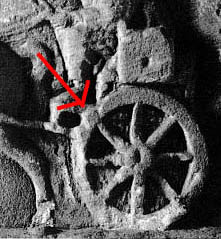
Fig. 19. Brake on the Rim29
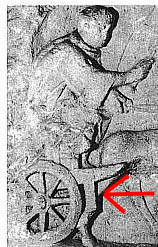
Fig. 20. Footboard Brake30
The 4-wheeled wagons were those used for heavy hauling and were drawn by teams of horses, mules or oxen. They feature a center or draught pole. The wheels had up to 12 spokes and the wagon body or platform was raised up above the axle31. From pieces of 4-wheeled wagons found, scholars have concluded that some of these Roman wagons appear to have been similar to German farms wagons build around 190032. Michel Molin who studied intensively the Langres style wagon, has reconstructed the brake system as one operating with a combination of brake shoes and a chain(See. Fig. 21). Amongst the 4-wheeled wagons were the angaria or the clabula mentioned in the Theodosian Code whose weight limit as I have previously mentioned was set at 1,500 Roman pounds.
Fig. 21. Michel Molin's sketch of the Langres wagon braking system33
For many years scholars assumed that Roman vehicles lacked a pivoting front axle. So much that was written about transport was based on the assumption that front axle pivots were lacking34.Even when Johann Ginzrot in 1830 presented diagrams in his book demonstrating the Roman construction of the pivoting front axles, it was not taken seriously35. However the doubters have been proved wrong as a result of several excavations in Bulgaria since the 19th Century. For years scholars who believed that the Romans had a pivoting front axles cited the image in Fig. 18 as support of this thesis, but their opponents have countered that the drawing merely demonstrates the artist's poor understanding and treatment of perspective.36.
A seminal publication on the topic of the Roman pivoting front axle is that by I. Venedikov entitled Trakijskata Kolesniza,which was published in Sofia in 1960. It is only in the Roman areas of Panonia and Thrace that the religious rites enabled the burial of wagons. Excavations in these areas resulted in a large number of complete wagon finds. As a result of these finds Venedikov reported that the front wheels were smaller then the back wheels which is typical for a pivoted front axle since it allows a smaller turning radius. In all or most of these complete finds the pivot pin was exactly at the position between the wheels where it was expected to be for a pivoting front axle. It is interesting to note that Venedikov made extensive use of Pollux's Onomasticon during his work on the pivoting front axle.37
In the 1970s the German C. W. Röring collected all material published so far on Roman wagon construction which was published in 1983. In this way the 1960 publication of Vendikov got closer attention in the west. With this paper and the metal pieces of a find from Wardartal, Bulgaria, Röring was able to reconstruct a Roman traveling coach for the Rheinisches Landesmuseum in Cologne38. With this reconstruction Röring demonstrated that not only did the Romans have pivoting front axles, but they also possessed a suspension system( See Fig. 22).
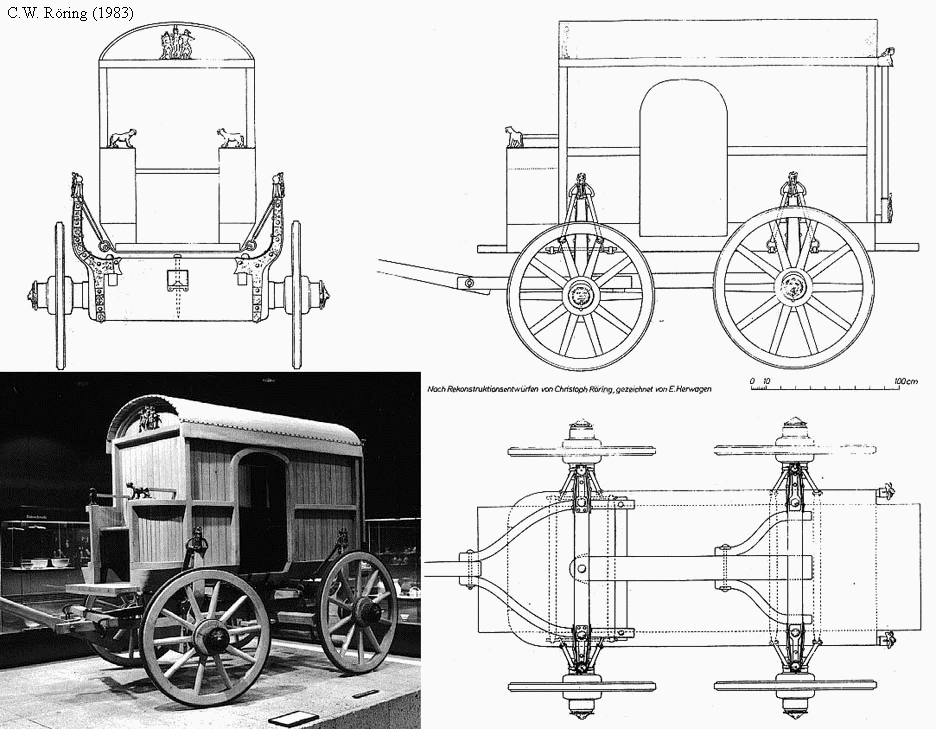
Fig. 22. Reconstruction of a Roman Traveling coach by C. W. Röring39
A comparison with box suspension for 2-wheeled carts.(See Fig 23) demonstrates the modernity of the Roman system. Lest anyone should think that this was unusual, a large number of passenger carts which were found buried in
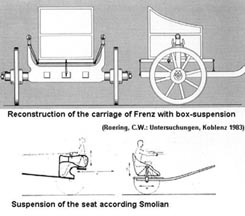
Fig 23. Frenz carriage Box Suspension40
Bulgaria(Thrace) also demonstrated suspension systems and front axles pivoting on massive spikes41. The dimensions of the Wardartal wagon also give us some idea of the actual size of Roman wagons - this traveling wagon has a width of 1.80m.(nearly 5.9 feet) and a length of nearly 3m.( almost 10 feet)-see Fig. 22. Based on information from ancient sources, a variety of wood was used in the construction of the wagon - the wheel hubs were made of elm, the spokes of ash, and the remaining portions including the passenger box were made of oak42.C.W. Röring has estimated in his reconstruction that the passengers, baggage and driver probably weighed in the neighborhood of 250 kg.43
This suspension system was not confined to just Thrace. Traces of it have been found throughout archaeological sites in the Roman Empire. The basic evidence for the spread of this system's existence is to be found in the proliferation of sites containing the metal remains of the suspension support system. Fig 23A illustrates the metal suspension pieces
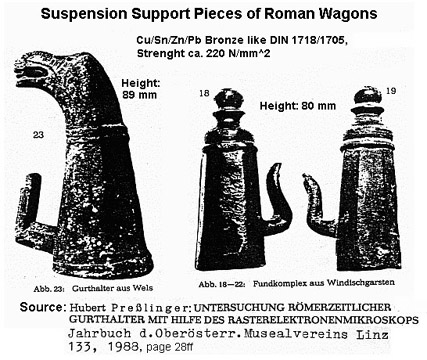
Fig. 23A. Roman metal suspension strap support44
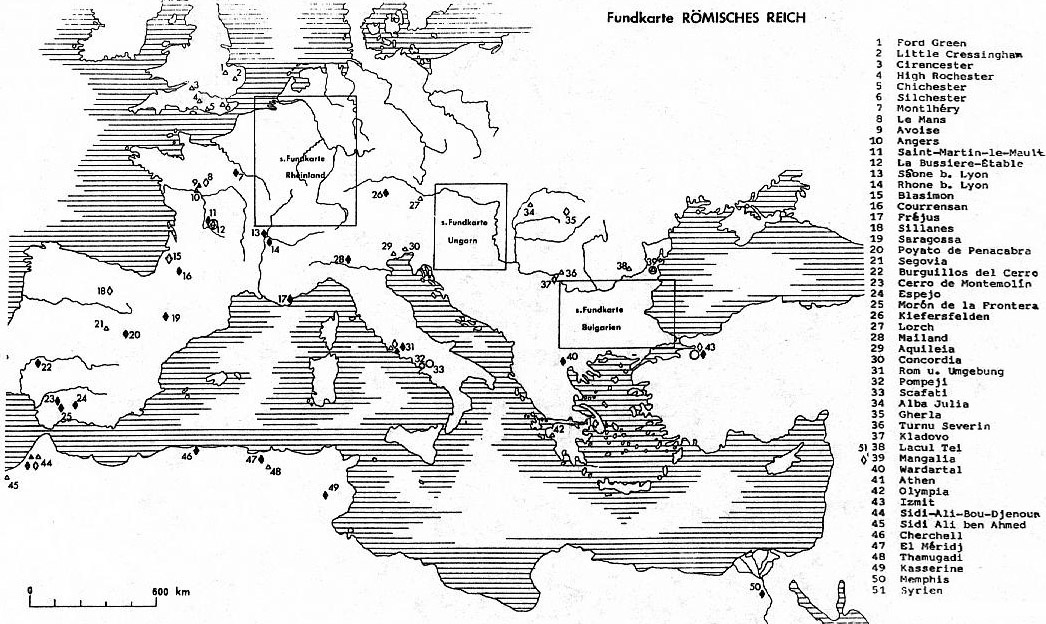
Fig. 23B. Archaeological sites in which Metal Roman
Suspension Supports have been found.45
used as part of the suspension system and figure 23B is a map showing the location of sites in which these metal pieces have been found. C. W. Röring noted that nearly 350 such pieces have been found at about 200 sites all over the Empire. They were either for two-or four wheeled- wagons. This demonstrates that the design of the Wardartal wagon was one widely used in the period of the Roman Empire, possibly as some sort of public transportation.
Hubert Preßlinger with the aid of a scanning electron microscope was able to analyze the metal quality found in these supports46. Based on his investigations Preßlinger classified the Roman material by comparing it to modern ones defined in Europe by DIN 1705 with a breaking strength of the metal of at least 220 N/mm2.47 This is close to the range of the lowest quality steel made today (229 N/mm2), but remember these metal support pieces are bronze in their composition and not steel. Preßlinger saw in the microscope that the Romans used cast bronze with a composition, cast quality and therefore strength similar to what we use today with this same material.48. The bottom line is that in these pieces we see a high degrees of metallurgical skills use to create suspension supports which had to least support a load 400 kg. This numbers includes an oak wagon body of 150 kg and passengers, baggage, driver of about 250 kg. Winifred Weber, a German authority on wagons, suggests that the Romans wagons of the nobility had mileage counters.49.
One interesting fact to be learned from this is that no evidence of a pivoting front axle or a suspension system can be seen in the iconography and mosaics of the period. The reason for this lies in the fact that most views are carved from the side, probably by stone masons who had little interest in the technical detail50. Ultimately this leads to the unanswered question of what pieces of the harness may have been left off by stone masons and even details of the wagons themselves. The technology of suspensions systems, so widespread in Roman times, seems to have vanished in the chaos of the Dark Ages. This technology reappears in the written records in 1374, but was still considered a sensation even by the early 15th century.51
So how much did these wagons weigh when empty? Lefebvre des Noëttes stated that the wagons were light and never exceeded 200 kg. empty52. Of course now we know that like so many statements he made that this is not true either. Using the iconography as a guide several scholars have attempted to estimate the empty weight of Roman wagons. A minimal approximation for the cisium of Igel (See Fig. 13) is on the order of 250-300 kg. and a half tonne (500 kg.) for larger wagons53. Michel Molin made an extensive study of the large wagon at Langres (See Fig. 24). His calculations led him to conclude that the wagon when full weighed about 800 kg. (500 kg, empty) and that the wagon itself was capable of carrying loads of one
and half tonnes54.
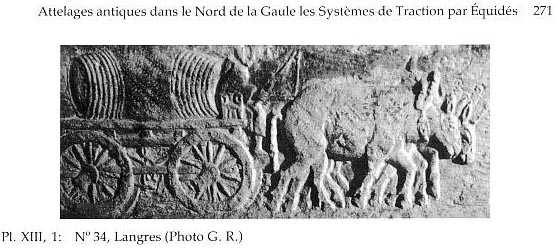
Fig. 24. The Wagon of Langres.55
Polfer also performed calculation on the Langres wagon. He calculated the barrel length at 1.7 m (at least), width 0.7 m, which results in a volume of 0.7 m3 (0.7m. cubed) at least with an empty wagon weight of 500 kg., empty barrel weight of 250 kg, and a driver weight of 80 kg.56. He concluded that all together the total weight is probably not under 1500 kg., or 750 kg. per mule and concluded that payloads about one tonne were in the normal range57. Doubtless the traveling coach of Wardartal like many large Roman wagons also weighed in the neighborhood of 500 kg according to Raepsaet58, but as we have seen by the calculations above it had the capacity to handle a much higher weight.
The weights of these wagons when empty are far in excess of what Lefebvre des Noëttes believed ancient wagons weighed. So once again it is necessary to discount the Commandant and his work.
When we compare the sophisticated construction of the Wardartal wagon with what is known about the wagons of the Middle Ages we cannot help but notice a decline in the technology from the Roman time through the Dark Ages, and early Middle Ages. It was not until almost the late Middle Ages that some aspects of the Roman technology were "rediscovered.". Basically wagon construction in the Middle Ages fell far below the standards set by wheelwrights in the Roman Empire. Notice that in Figure 24A - the Oseberg find dated at 850 AD, the crude construction of the wheels. It can be seen that the wheels contain no metal banding and that instead of using a single-piece felly, the wheelwright crudely cut

Fig. 24A. Wagon from Oseberg ca. 850 A. D.59
sufficient numbers of fellies, joining them together with a wooden dowel, to create each wheel. Compared to the Wardartal wagon the radius of each arc is quite thick. It also appears that throughout much of the Medieval period the front wheels did not pivot. John Langdon wrote that the pivoting front axle was not introduced to Europe possibly until as late as the 14th Century60, yet C.W. Röring,'s reconstruction demonstrated that it was known in Roman times. However, one should note that although the Langdon book was published only a few years after the reconstruction of the Wardartal wagon and C. W. Röring's significant publication on the topic, it appears as if Langdon was unfamiliar with this material which consequently renders portions of Langdon's 1986 book outdated. But it is significant that Langdon does not believe that pivoting front axles became part of Medieval wagon construction until as late as the 14th Century as it is further evidence of the decline in wagon construction since the time of the Roman Empire. It would not be until the late Middle Ages that the population would re-discover some of the Roman's skill in wagon construction.
Iron banding of wheels which was common during the Roman Empire also appears to have been lost to the Middle Ages. In the late Middle Ages the majority of wagon wheels were still without metal banding, and exceptions were considered noteworthy one such exception was noted explicitly by a writer in 1320.61 However, by the end of the Middle Ages this knowledge appears to have been rediscovered and some efforts were made in the military area to advance beyond Roman technology. F. L. Taylor describes the measures taken at the end of the 15th C. to greatly improve the mobility of artillery of all sizes as well as their ammunition wagons. The full details of the technology are not described by Taylor, and neither does there appear to have been any indications that such military innovations were either entirely suitable or immediately adaptable to civilian usage62. Basically the Middle Ages were not one of technological innovation when it came to wagon construction -- that would only happen well after the Middle Ages. Indeed much of the period was doubtlessly spent in re-learning Roman technology in the field.
- Langdon, p. 117
- Ibid., p. 120. See also Spruytte, pp.98-121
- Ibid., p. 115
- Raepsaet, 1997, p. 49
- Pisani, p. 86.
- Raepsaet, 1982, p. 236
- Leighton p. 76
- Ibid.
- Ibid.
- Leighton, p. 117
- Kugler, p. 249
- Künzel, pp. 473-505
- Ibid.
- Visy, p. 272
- Künzel, photographic appendix
- as cited in Leighton, p. 124
- Ibid
- Amouretti, p. 225
- Visy, p. 324
- Ibid.
- Ibid.p. 272
- The calculation are performed by SENECA based on the following formulae. The breaking strength of a single oak (30 N/mm2) axle part with ab axle diameter = 100mm. is 23 tons and with a diameter of 138mm., the breaking strength is 45 tons. The safety factor in normal oak building wood (that which would be be used for 100 years or more) is 30 times. That would mean a single wheel load of an axle whose diameter is 100mm. is 767 kg. and 138mm. is 1500 kg..
- Visy pp. 272 ff.
- Ibid.
- Ibid. p. 296
- Ibid.
- Langdon, p. 115
- Raepsaet, 1982, p. 236
- Ibid. Pl. VIII, No. 8.
- Ibid. No. 4
- Ibid., pp. 236-37
- Hayen, P. 236.
- Molin, p. 107
- Leighton, p. 118 - see also Langdon, Horse, Oxen,and Technology innovation, p.155
- Leighton, pp. 118-120. Ginzrot's book,Die Wagen und Fahrwerke der Griechen und Römer und anderer alter Völker; nebst der Bespannung, Zäumung und Verzierung ihrer Zug- Reit- un Last-Thiere (Munich, 1817) was based on his reading of Pollux's Onomasticon which listed the names of vehicles and their parts. Pollux's book is from the 2nd century AD.
- Ibid., p. 78
- Röring, p. 15
- Röring, passim
- Ibid
- Ibid
- Ibid., pp. 81-83
- Telephone conversation between C. W Röring and SENECA on 4/16/99
- Ibid.
- Preßlinger
- Röring, passim.
- Preßlinger, passim
- Ibid.
- Ibid.
- Weber, p. 108. Hero of Alexandria describes this sort of device in his Dioptra.
- Greene, 1990, p. 38
- Wackernagel, p. 200
- Lefebvre des Noëttes, 1924 , p. 12
- Raepsaet, 1985, p. 1440
- Molin, Op. Cit. Molin's article contains details information on how he arrived at his calculations.
- Raepsaet, 1982, Pl. XIII, 271
- Polfer, pp. 533-35
- Ibid.
- Raepsaet, 1982, p.238
- Hayen, p.137
- Langdon, Horse, Oxen, and Technology Innovation, p.155
- Aubin/Zorn p. 128
- Taylor, pp. 83-8